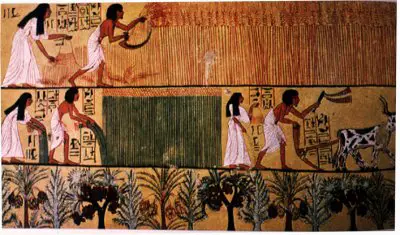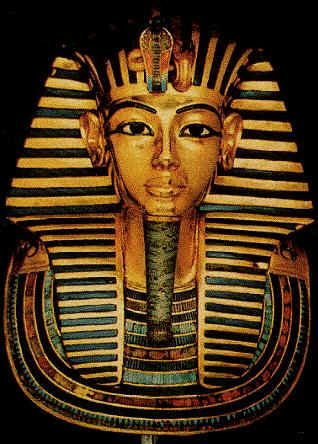Food and Drink
The basic diet of the people remained the same for a long time. The cuisine of the ancient Egyptians had resemblance with the cuisine of the modern Egyptians.Their food consisted of bread and beer along with vegetables like onions, garlic, fruits like date and fig. Meat and wine were consumed by everyone in general on certain occasions while the rich had it very frequently.

Meat, fish or even fowl consumed were either with salt or dried, cooked or roasted, or even grilled. The ancient Egyptians ate with their hands. The social ranking of an individual was a deciding factor in the food he could consume. The rich could afford a variety of food items while the poor were forced to stick to the normal food they could afford. Beer and Wine were customary drinks for all classes. Honey was used instead of sugar. Butter and cheese were served at banquets held by the rich.
Architecture and Art
The State funded and organized the construction of buildings for religious purposes. These structures also formed a source of reinforcing the power of the Pharaoh. The ancient Egyptians were skilled builders and constructed huge structures with perfection and accuracy.
Houses were made from mud bricks. The rich had palaces with detailed structures and their floors and walls were ornamented with people, birds, etc. Temples and tombs were made out of stone rather than bricks. The famous architecture of the ancient Egypt includes the Great Pyramids of Giza and the Temples at Thebes.

During the Old Kingdom, there existed a set of principles that were necessary to follow. This principle resisted outside influence and internal changes. Pictures and texts were carved on the tombs, temple walls, coffins and even statues. The ancient Egyptian art served the religious and political purposes with perfection and clarity.
Wood was used as a replacement to carve statues. Colors like red and yellow were obtained from iron-ore, blue and green from copper ores, black from charcoal and white from limestone. In ancient Egypt, Amarna art was common which was followed since the Amarna era. This type of art was remarkably different than other Egyptian art styles.
Religious Beliefs
The ancient Egyptians (In Egyptians Culture) strongly believed in God and life after death. The rule of Pharaohs was laid on the foundation of Divine Rights of Kings. The Egyptians were of the view that to please gods they should make some offerings and pray to God. Gods were worshiped in temples that were under the care of the priests who acted on behalf of the King.
 According to Egyptian Culture, the statue of the God was placed in the heart of the temple. It was only on selected few occasions that the statue of the god was open for public worship. After the New Kingdom, the role of the King as a mediator between God and people received less emphasis. In fact, the priests created a system of revelation wherein people could directly communicate with God.
According to Egyptian Culture, the statue of the God was placed in the heart of the temple. It was only on selected few occasions that the statue of the god was open for public worship. After the New Kingdom, the role of the King as a mediator between God and people received less emphasis. In fact, the priests created a system of revelation wherein people could directly communicate with God.
Another dominant belief was that humans are made of physical and spiritual aspects and every individual has his own shadow, soul, life force and a name (In Egypt Culture). It was believed that heart was the place for emotions and thoughts. After the death of the person, the final goal of the deceased was to unite his life force and soul to be regarded as the ‘blessed dead’.
More information on: Ancient Egyptian Culture And Traditions1,
Ancient Egyptian Culture And Traditions2